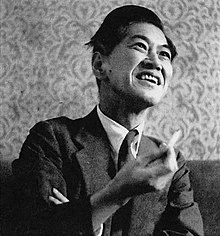

Yusuke Hagihara
| |
|---|---|

Hagihara in 1954
| |
| Born | 28 March 1897
Osaka, Japan
|
| Died | 29 January 1979
Tokyo, Japan
|
| Alma mater | Tokyo Imperial University (BSc 1921) University of Tokyo (D.Sc. 1930) |
| Scientific career | |
| Fields |
|
| Institutions | University of Tokyo Tokyo Astronomical Observatory Japan Academy |
| Notable students | Yoshio Fujita |
Yusuke Hagihara (萩原 雄祐, Hagihara Yūsuke, 28 March 1897 in Osaka – 29 January 1979 in Tokyo) was a Japanese astronomer noted for his contributions to celestial mechanics.[1]
Hagihara graduated from Tokyo Imperial University with a degree in astronomy in 1921 and became an assistant professor of astronomy there two years later.[2] In 1923 the Japanese government sent him abroad as a traveling scholar. Hagihara went to Cambridge University in England to study differential equations under the mathematician Henry Frederick Baker[2] and relativity alongside Paul Dirac under the astrophysicist Sir Arthur Stanley Eddington.[1][3] He was a visiting scholar in France, Germany, and the United States.[1]
He returned to Japan in 1925 but left for the United States three years later to study the topology of dynamical systems at Harvard University under George David Birkhoff on a Rockefeller Foundation Fellowship.[3]
Hagihara finished his studies at Harvard in 1929 and returned again to the University of Tokyo, where, in 1930, he completed a D.Sc. dissertation on the stability of satellite systems.[2] In 1935, he published a paper showing that the trajectory of a test particle in the Schwarzschild metric can be expressed in terms of elliptic functions.[3] For more than a decade after 1937, he investigated the distribution of electron velocities in planetary nebulae.[3]
He was promoted to full professor at the University of Tokyo in 1935.[2] From 1945 to 1957 he was the director of the Tokyo Astronomical Observatory and subsequently was a professor at Tohoku University (1957–1960) and president of Utsunomiya University (1961–1967).[3] In 1961 he was elected vice-president of the International Astronomical Union and president of the IAU's commission on celestial mechanics.[2]
He retired from all of his official duties, except for the Japan Academy, in 1967 and devoted himself to writing his comprehensive five volume work, Celestial Mechanics, which was based on his lecture notes.[2]
Hagihara was regarded as a quiet and cultured gentleman, an excellent teacher and a capable administrator.[1][2]
He has pointed out the importance of the post-Newton models for celestial mechanics, namely that developed by Georgi Manev.[citation needed]
| International |
|
|---|---|
| National |
|
| Academics |
|
| Other |
|